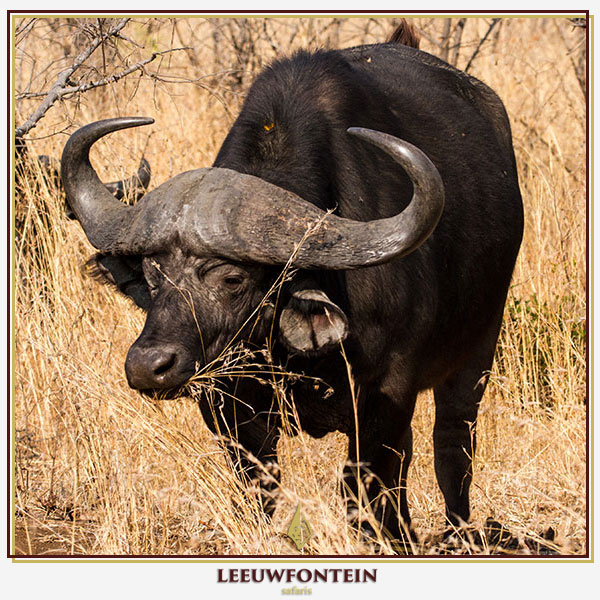The Cape buffalo (Syncerus caffer), also known as the African buffalo, is one of the most sought-after and challenging big game animals in South Africa. As one of the iconic members of Africa’s ‘Big Five,’ the Cape buffalo is revered for its size, strength, and unpredictability. Hunting this formidable species requires skill, patience, and an in-depth understanding of its behavior and habitat. This profile explores the physical characteristics, Rowland Ward trophy measurements, behavior, habitat, hunting strategies, recommended equipment, shot placement, and ethical hunting considerations specific to the Cape buffalo in South Africa.
Cape buffaloes are large, muscular bovines that display remarkable resilience and endurance. Adult males, known as bulls, can weigh between 500 and 900 kilograms (1,100 to 2,000 pounds), while females are generally smaller, ranging from 350 to 700 kilograms (770 to 1,500 pounds). At the shoulder, they stand between 130 and 150 centimeters (51 to 59 inches) tall, making them one of the largest land mammals in South Africa.
Their hide is thick and dark, usually black or dark brown, with a sparse covering of coarse hair. A notable feature of the Cape buffalo is its broad, curved horns, which sweep outward and upward from the head. Males develop a solid, helmet-like structure at the base of their horns, known as a “boss,” which is used in dominance battles. Female buffaloes also have horns, but they are slimmer and lack the pronounced boss seen in mature bulls.
Trophy hunters consider Cape buffalo horns among the most impressive of all African game animals. The Rowland Ward record book recognizes exceptional specimens based on the measurement of the outside spread of the horns. A trophy Cape buffalo typically has a horn spread exceeding 100 centimeters (40 inches), though some exceptional bulls have recorded spreads of over 130 centimeters (51 inches).
In addition to spread, trophy quality is assessed based on the development of the boss, symmetry, and overall horn mass. The Safari Club International (SCI) scoring system also considers horn length and circumference, emphasizing mass and shape over sheer spread.
Cape buffaloes are highly social animals, typically forming herds that can number from a few individuals to several hundred. These herds are usually composed of cows, calves, and young bulls, while older males often form smaller bachelor groups or become solitary. Solitary bulls, known as "dagga boys," are particularly prized by hunters as they tend to be more aggressive and elusive.
Buffaloes are primarily grazers, feeding on a variety of grasses and sometimes supplementing their diet with shrubs and foliage. They rely heavily on water sources and must drink daily, making their movements relatively predictable in certain regions.
In South Africa, Cape buffaloes inhabit savannas, grasslands, and dense woodlands, particularly in protected reserves such as the Kruger National Park, private game reserves, and hunting concessions. Their strong survival instincts and acute senses make them one of the most challenging animals to hunt.
Hunting Cape buffalo requires a strategic approach, as their intelligence, toughness, and tendency to charge when wounded make them dangerous adversaries. Several hunting techniques have proven effective:
Stalking and Spotting: This method involves tracking buffalo on foot by locating fresh spoor, dung, and feeding signs. Hunters must be patient and move cautiously to avoid detection while closing the distance for a shot.
Ambush Hunting: Buffaloes frequent waterholes and grazing areas at dawn and dusk. Setting up near these locations can provide opportunities for a well-placed shot as they approach.
Tracking: Experienced professional hunters (PHs) play a crucial role in buffalo hunts, helping to interpret tracks, predict movement patterns, and ensure safety.
Calling: In some cases, mimicking the distress calls of a calf or another buffalo can lure a dominant bull into range.
Given the buffalo's thick hide, strong bones, and tenacity, hunters must be prepared for a follow-up shot, as a wounded buffalo is extremely dangerous and will often attempt to circle back and charge.
When hunting Cape buffalo—classified as dangerous game—you must use a rifle and ammunition capable of deep penetration and bone-breaking force.
Caliber Recommendations (Minimum legal in South Africa: .375 caliber):
Rifle Type:
Ammunition:
Use premium, heavy-for-caliber bullets designed for dangerous game, such as:
Bullet weight should be 300 grains or more for .375, and 400+ grains for larger calibers.
Solids (non-expanding) are often used for follow-up shots or brain/spine shots at close range.
Proper shot placement is essential, especially with dangerous game like Cape buffalo. Poor placement can lead to prolonged suffering and life-threatening encounters.
Vital Shot Zones:
Follow-up Shots:
Ethical Considerations:
The Cape buffalo (Syncerus caffer) embodies the thrill and challenge of dangerous game hunting in South Africa. With its formidable size, unpredictable nature, and reputation for toughness, it offers one of the most intense hunting experiences available.
Success in Cape buffalo hunting requires a deep understanding of its behavior and habitat, the use of appropriate firearms and ammunition, and a commitment to ethical hunting practices. Whether stalking through thick bush, tracking a herd at dawn, or facing the adrenaline surge of a charging bull, the pursuit of Cape buffalo is both a test of skill and a tribute to the traditions of African big-game hunting.
By respecting the animal, practicing ethical hunting, and meticulously documenting trophy specimens, hunters contribute to the conservation of this iconic species while partaking in one of the most exhilarating experiences the African wilderness has to offer.

| # | NAME | |
| 1. | Species List | |